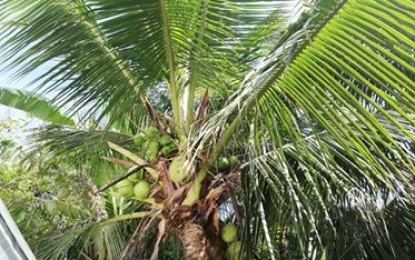
HYBRID COCONUT. A regular coconut planted by coco-farmers in a backyard. The Philippine Coconut Authority on Friday (June 26, 2020) is embarking on a hybridization project that is expected to provide farmers with higher production output. (PNA photo by Perla G. Lena)
ILOILO CITY --Although sidelined by the coronavirus disease 2019 (Covid-19) pandemic, the Philippine Coconut Authority (PCA) will push through with its hybridization project in “small quantities”.
Currently, PCA started with 61 model farms all over Western Visayas with an area of not less than three hectares for each farm.
These include 16 model farms in Aklan; two in Antique; 10 in Capiz; nine in Guimaras; 13 in Iloilo; and 11 in Negros Occidental.
PCA is still waiting for 36,000 seed nuts that are being sourced from their center in Bohol, said PCA Western Visayas manager Jeffrey de Los Reyes in a phone interview Friday.
For the 61 model farms, PCA needs 54,000 seed nuts.
De Los Reyes said that the mother palm of a hybrid coconut to be distributed comes from a selected dwarf variety that is married to a desired tall variety.
The mother palm dwarf coconut bears more fruit. It starts to bear fruit in less than four years after being planted. The tall variety on the other hand has thick meat.
“Their offspring becomes a hybrid, which we distribute. The hybrid produces three times more than the local source,” he said.
The hybrid coconut bears fruit earlier and bears fruit three times more than the local variety. Its meat is also thicker.
Under the project, the PCA does not give assistance, except for the seedlings. “We chose those who are really interested,” he added, saying that “growing is different from planting”.
“This is a continuing project because the target is five million trees throughout the country until 2022,” de Los Reyes said.
Meanwhile, he said there is still a demand for coconut although the price of the traditional copra is still low.
“However, the demand for buko as food or beverage is high. So what we will do is that we should diversify,” he said.
De Los Reyes added that in any gathering, it would be better to give buko juice instead of soda because it is healthier. (PNA)
